Whether you’re offering a new course, reworking an existing one or just getting started in your higher education instruction, the college syllabus is an invaluable tool that helps both you and your students have a successful semester. With a comprehensive syllabus, you can provide all the necessary information students need to for your class—while making a positive impression on them that sets the tone for the term.
Using the feedback and insights we’ve gleaned working with instructors like you, we’re breaking down a FREE course syllabus template you can use to optimize your class prep and impact your students. Read on to learn more!
The Building Blocks of a Rock-Solid Syllabus
Before diving into the dos, don’ts and elements of a syllabus, it’s important to understand the building blocks. Keeping these in mind before creating your syllabus can make it easier to articulate your objectives and provide students with an easy-to-follow rubric as they navigate a semester.
Language
How you write a document can be just as important as what you include in it. With about 79% of readers skimming pages instead of reading them, condensing your syllabus information into clear and concise writing can make the difference between a syllabus that’s skimmed and forgotten, and one that’s referenced consistently over the course of a semester.
Knowing this, consider using plain language in your syllabus—keeping in mind the following best-practices:
- Organize information from most important to least important
- Keep sentences and paragraphs short and easily scannable
- Use common phrases over discipline-specific jargon whenever possible
- Keep acronyms and “letter soup” to a minimum
- Define uncommon terms
- Use lists, tables and headings for easy navigation
Layout
Like writing, the structure of your syllabus can drastically improve—or hinder—its effectiveness. Your syllabus should include clear headers, visuals and other elements that make it easy for students to understand each section. From contact information and office hours, to grading rubrics and class schedules, the easier it is for students to find what they’re looking for, the easier it will be to use that information to succeed in class.
Links and Resources
Thanks to the emergence of digital learning in the classroom, the inclusion of links and resources within the actual document can transform a syllabus from passive text into a resource students can use regularly. Consider including resources dedicated to helping students master key course concepts alongside broader tools students can use to navigate their academic and non-academic challenges.
Building Your Syllabus: Elements for Success
With the essential building blocks of an effective syllabus top-of-mind, let’s dive into our templated syllabus—explaining the importance behind each section alongside some tips and tricks you can use to make this template unique for your own class needs.
Course Syllabus Part One: General Information
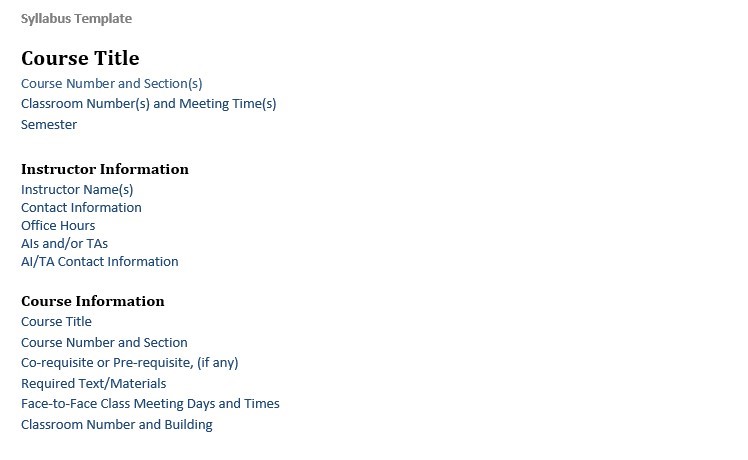
The beginning of your syllabus should include all the most basic information students need. Regardless of discipline, this information should be included at the top of the page, making it easy for students to understand the who, when, where and what of your class. Consider including who is teaching the course, where they should go to attend the class (including online), what materials they need and how/when/where to reach out for additional help.
Course Syllabus Part Two: Description, Objectives and Expectations
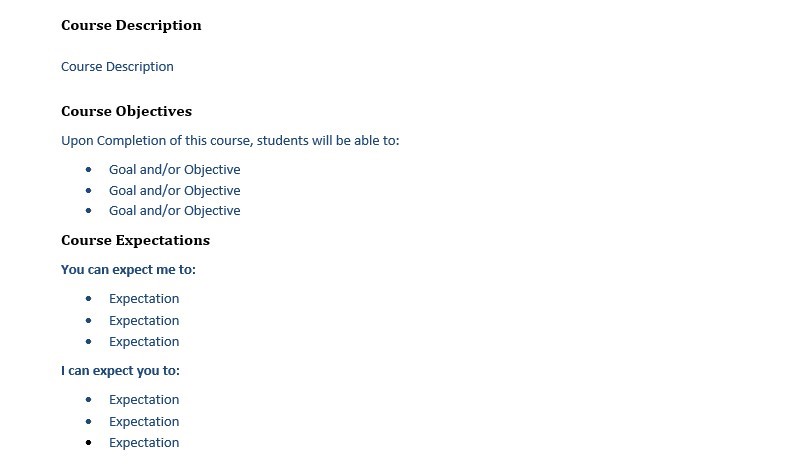
In this section, content will vary not only by discipline, but also by your unique preferences, teaching style and ideal classroom culture. Below, you’ll find the core information to include in your syllabus but consider personalizing each section to articulate your specific needs.
Course Description: For your course description, keep the content consistent with the description found in the course listings and any prerequisite courses related to the current course. Consider providing information that can motivate students and make them feel welcome in your class. For example, a brief description of how this course will help them prepare for future work or careers in the field.
Course Objectives: The objectives section of your syllabus should aim to define what students should be able to learn or do after successfully completing your course. When possible, demonstrate both the hard and soft skills you are aiming to help your students master. For example:
“Students should be able to articulate course themes and demonstrate how to apply those themes in their coursework.”
Course Expectations: As you describe your expectations for the course, consider using language that paints a clear picture of what you will do and what you’d like students to do. For example:
“Students should be able to participate in class discussions while respecting and considering the opinions of their fellow classmates.”
“Students can depend on me to start and end class on time.”
Course Syllabus Part Three: Course Policies, University Policies and Resources
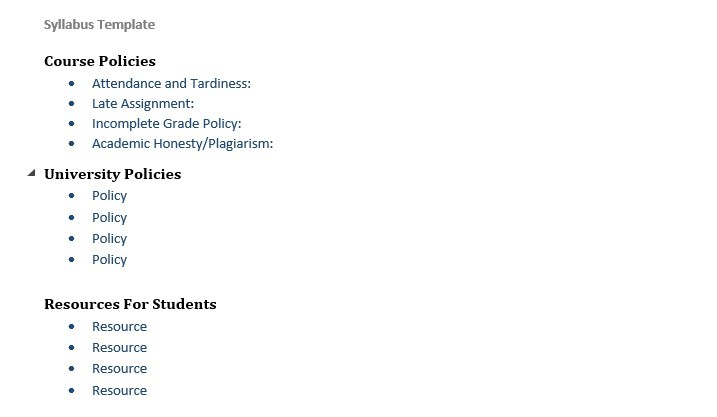
Here, you have the opportunity to set the tone for your semester—laying out the rulebook for your students to follow in class. Additionally, the resources section can be used to provide students with more information on these policies—as well as tools to help them in and out of the course.
Course Policies: In this section, clearly define your position on attendance, participation, missing or late assignments, incomplete grades etc. If your institution also requires you to list specific campus-wide policies, keep the language consistent with the original descriptions. If possible, include links to each policy page on your institution’s website.
Resources: Your syllabus can be a great place to include resources dedicated to helping students with academic and non-academic challenges that can impact their learning. Consider using this section to include resources like:
- Digital learning platform help
- Disability resources
- Learning center information
- Mental health services
- Related videos and outside reading
- Lesson tutorials
- Lesson-specific concept help
By including links and descriptions of useful tools and help in your syllabus you can ensure students have the support they need to thrive in your class.
Course Syllabus Part Four: Assignments, Scheduling and Grading
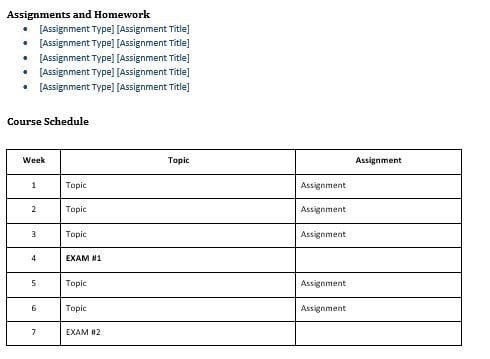
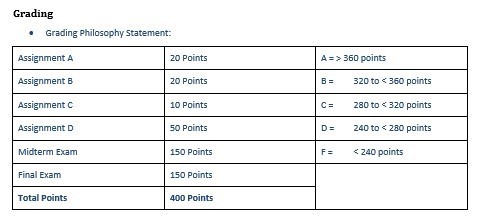
In this section, outline what assignments are part of the course, when those assignments are due and what each assignment’s impact is on their overall grade. In this template, we include space to clearly lay out coursework alongside scheduling and grading visuals to make it as easy as possible for students to understand.
Additionally, we included a Grading Philosophy Statement above the grading rubric to ensure your grading policy is understood in relation to the coursework you assign your students.
Ready to Build Your Own Syllabus?
We hope this article has made it easier for you to make your own syllabus. If you liked the sections we’ve used as a reference here, download your own FREE template doc below!

